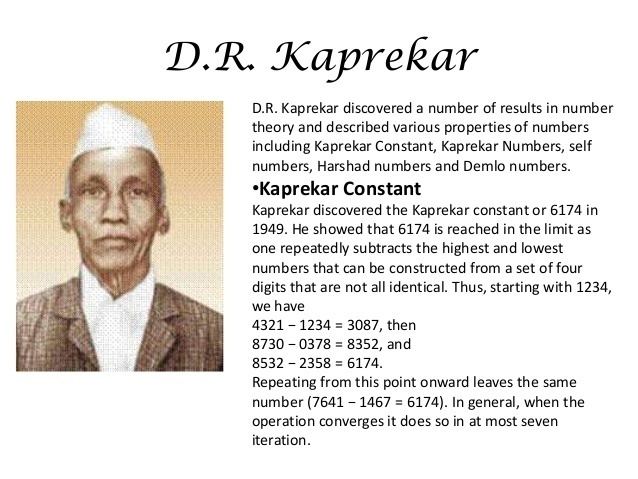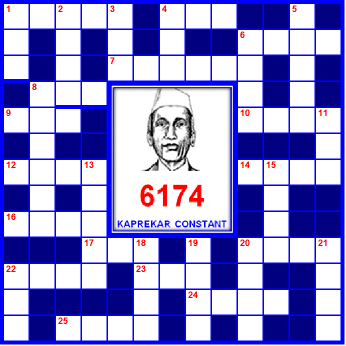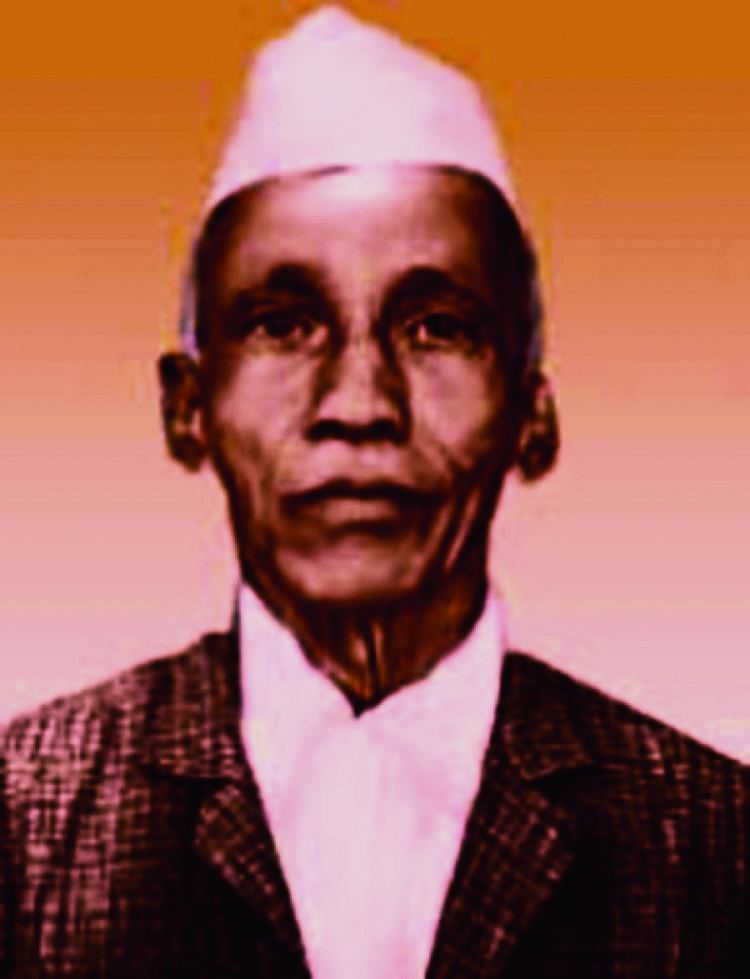Nationality Indian Died 1986, Deolali Role Mathematician | Occupation School teacher Education Fergusson College | |
 | ||
Known for Results in recreational mathematics Similar A A Krishnaswami Ayyangar, K Ananda Rau, Satyendra Nath Bose | ||
Magical Number 6174 Kaprekar's Constant
Dattathreya Ramchandra Kaprekar (1905–1986) was an Indian recreational mathematician who described several classes of natural numbers including the Kaprekar, harshad and self numbers and discovered the Kaprekar constant, named after him. Despite having no formal postgraduate training and working as a schoolteacher, he published extensively and became well known in recreational mathematics circles.
Contents
- Magical Number 6174 Kaprekars Constant
- Biography
- Discoveries
- Kaprekar constant
- Kaprekar number
- Devlali or Self number
- Harshad number
- Demlo number
- See also
- References

Biography

Kaprekar received his secondary school education in Thane and studied at Fergusson College in Pune. In 1927 he won the Wrangler R. P. Paranjpe Mathematical Prize for an original piece of work in mathematics.

He attended the University of Mumbai, receiving his bachelor's degree in 1929. Having never received any formal postgraduate training, for his entire career (1930–1962) he was a schoolteacher at Nashik in Maharashtra, India. He published extensively, writing about such topics as recurring decimals, magic squares, and integers with special properties. He is also known as "Ganitanand" (गणितानंद)
Discoveries

Working largely alone, Kaprekar discovered a number of results in number theory and described various properties of numbers. In addition to the Kaprekar constant and the Kaprekar numbers which were named after him, he also described self numbers or Devlali numbers, the harshad numbers and Demlo numbers. He also constructed certain types of magic squares related to the Copernicus magic square. Initially his ideas were not taken seriously by Indian mathematicians, and his results were published largely in low-level mathematics journals or privately published, but international fame arrived when Martin Gardner wrote about Kaprekar in his March 1975 column of Mathematical Games for Scientific American. Today his name is well-known and many other mathematicians have pursued the study of the properties he discovered.
Kaprekar constant

In 1949, Kaprekar discovered an interesting property of the number 6174, which was subsequently named the Kaprekar constant. He showed that 6174 is reached in the limit as one repeatedly subtracts the highest and lowest numbers that can be constructed from a set of four digits that are not all identical. Thus, starting with 1234, we have:
4321 − 1234 = 3087, then8730 − 0378 = 8352, and8532 − 2358 = 6174.Repeating from this point onward leaves the same number (7641 − 1467 = 6174). In general, when the operation converges it does so in at most seven iterations.
A similar constant for 3 digits is 495. However, in base 10 a single such constant only exists for numbers of 3 or 4 digits; for other digit lengths or bases other than 10, the Kaprekar's routine algorithm described above may in general terminate in multiple different constants or repeated cycles, depending on the starting value.
Kaprekar number
Another class of numbers Kaprekar described are the Kaprekar numbers. A Kaprekar number is a positive integer with the property that if it is squared, then its representation can be partitioned into two positive integer parts whose sum is equal to the original number (e.g. 45, since 452=2025, and 20+25=45, also 9, 55, 99 etc.) However, note the restriction that the two numbers are positive; for example, 100 is not a Kaprekar number even though 1002=10000, and 100+00 = 100. This operation, of taking the rightmost digits of a square, and adding it to the integer formed by the leftmost digits, is known as the Kaprekar operation.
Some examples of Kaprekar numbers in base 10, besides the numbers 9, 99, 999, …, are (sequence A006886 in the OEIS):
Devlali or Self number
In 1963, Kaprekar defined the property which has come to be known as self numbers, which are integers that cannot be generated by taking some other number and adding its own digits to it. For example, 21 is not a self number, since it can be generated from 15: 15 + 1 + 5 = 21. But 20 is a self number, since it cannot be generated from any other integer. He also gave a test for verifying this property in any number. These are sometimes referred to as Devlali numbers (after the town where he lived); though this appears to have been his preferred designation, the term self number is more widespread. Sometimes these are also designated Colombian numbers after a later designation.
Harshad number
Kaprekar also described the Harshad numbers which he named harshad, meaning "giving joy" (Sanskrit harsha, joy +da taddhita pratyaya, causative); these are defined by the property that they are divisible by the sum of their digits. Thus 12, which is divisible by 1 + 2 = 3, is a Harshad number. These were later also called Niven numbers after a 1977 lecture on these by the Canadian mathematician Ivan M. Niven. Numbers which are Harshad in all bases (only 1, 2, 4, and 6) are called all-Harshad numbers. Much work has been done on Harshad numbers, and their distribution, frequency, etc. are a matter of considerable interest in number theory today.
Demlo number
Kaprekar also studied the Demlo numbers, named after a train station 30 miles from Bombay on the then G. I. P. Railway where he had the idea of studying them. These are the numbers 1, 121, 12321, …, which are the squares of the repunits 1, 11, 111, ….
